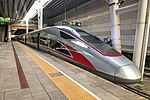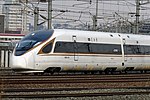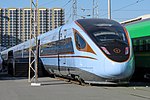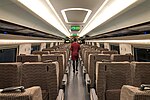Fuxing (train)
This article has multiple issues. Please help improve it or discuss these issues on the talk page. (Learn how and when to remove these template messages)
|
| Fuxing (Rejuvenation) | |
|---|---|
 CR400AF-0208 made by CRRC Qingdao Sifang and CR400BF-0507 made by CRRC Changchun are tested on Beijing Circular Railway. The paint is non-standard. | |
| In service | August 15, 2016 – Present |
| Manufacturer | CRRC Qingdao Sifang CRRC Changchun Railway Vehicles CRRC Tangshan Railway Vehicle |
| Formation | CR400AF/BF/CR300AF/BF/KCIC400AF: 8 cars/trainset (4M4T)[1] CR400AF–A/BF–A:16 cars/trainset (8M8T) CR400AF–B/BF–B:17 cars/trainset (8M9T) |
| Capacity | CR400AF/BF: 556 or 576 CR400AF–A/BF–A: 1193 CR400AF–B/BF–B: 1283 |
| Operators | China Railway Corporation PT Kereta Cepat Indonesia China Laos–China Railways Company Limited |
| Lines served | |
| Specifications | |
| Train length | CR400AF: 209 m (685 ft 8 in)[1] CR400AF–A: 414 m (1,358 ft 3 in) CR400BF: 209.06 m (685 ft 11 in) CR400BF–A: 414.26 m (1,359 ft 1 in) CR400AF–B: 439.9 m (1,443 ft 3 in) CR400BF–B: 439.9 m (1,443 ft 3 in) |
| Width | 3,360 mm (11 ft 0 in)[1] |
| Height | 4,050 mm (13 ft 3 in)[1] |
| Platform height | 1,250 mm (4 ft 1.2 in) |
| Maximum speed |
|
| Axle load | <17 t (16.7 long tons; 18.7 short tons)[1] |
| Traction system | Water cooling IGBT-VVVF inverter control (Zhuzhou CRRC Times Electric) |
| Traction motors | YQ-625 external sector 3-phase AC induction motor (Zhuzhou CRRC Times Electric) |
| Electric system(s) | 25 kV 50 Hz AC Overhead catenary |
| Current collector(s) | Pantograph |
| Track gauge | 1,435 mm (4 ft 8+1⁄2 in) standard gauge |
| Fuxing | |||||||
|---|---|---|---|---|---|---|---|
| Simplified Chinese | 复兴号 | ||||||
| Traditional Chinese | 復興號 | ||||||
| Literal meaning | Rejuvenation | ||||||
| |||||||
| Alternative Chinese name | |||||||
| Simplified Chinese | 中国标准动车组 | ||||||
| Traditional Chinese | 中國標準動車組 | ||||||
| Literal meaning | China Standardized EMU | ||||||
| |||||||
Fuxing (simplified Chinese: 复兴号; traditional Chinese: 復興號; pinyin: Fùxīng Hào; lit. 'Rejuvenation'), also known as the CR series EMU (or as the Fuxing Hao), is a series of high-speed and higher-speed EMU trains operated by China Railway High-speed (CRH) and developed by CRRC. They are the first successful high-speed trains to be fully designed and manufactured in China.[2][3]
Initially known as the China Standardized EMU, development on the project started in 2012, and the design plan was finished in September 2014. The first EMU rolled off the production line on 30 June 2015.[4][5] The series received its current designation of Fuxing in June 2017, with nicknames such as "Red Dragon" (CR400AF) and "Golden Phoenix" (CR400BF) for certain units.[6] It is among the world's fastest conventional high-speed trains in regular service, with an operating speed of 350 km/h (220 mph) for the CR400AF and CR400BF models.
Internationally exported versions of the train sets also operate in Indonesia on the Jakarta-Bandung high-speed railway from 2023, with a derivative version of the CR400AF, also known as the KCIC400AF or "Komodo Merah" (literally: red komodo dragon)[7][8] or "Petir Merah" (literally: red lightning).
The upcoming CR450, designed for a maximum operating speed of 400 km/h (250 mph), is expected to enter service by 2025.[9] In 2023, Chinese state media reported a CR450 train attained a speed of 453 km/h (281 mph) during a test run.[10]
History
[edit]Background
[edit]In 2004, China's Ministry of Railways contracted Bombardier Transportation, Kawasaki Heavy Industries and Alstom to supply the first high-speed trains for China, which later known as Hexie (simplified Chinese: 和谐号; traditional Chinese: 和諧號; pinyin: Héxié Hào; lit. 'Harmony'), with Chinese partners CNR and CSR. The four foreign companies agreed to manufacture high-speed trains for China as well as provide technology transfer for local production.
Some of the Hexie (Harmony) train sets are manufactured locally through technology transfer, a key requirement for China. The signalling, track and support structures, control software, and station design are developed domestically with additional foreign elements. By 2010, the track system as a whole was predominantly Chinese.[11] China currently holds many new patents related to the internal components of these trains, re-designed in China to allow the trains to run at higher speeds than the foreign designs allowed.
However, most of Hexie's (Harmony's) patents are only valid within China, and as such hold no international power. The weakness of intellectual property of Hexie caused obstacles for China to export its high-speed rail related technology, which led to the development of the completely redesigned train brand called Fuxing (simplified Chinese: 复兴号; traditional Chinese: 復興號; pinyin: Fùxīng Hào; lit. 'Rejuvenation') that is based on local technology.[11][12][13]
Development
[edit]Started in 2012, CNR Changchun Railway Vehicles (now CRRC Changchun Railway Vehicles), under the guidance of China Railway Corporation, with a collection of enterprises, universities, and research institutes, carried out the development of a more advanced China Standardized EMU. In December 2013, CRRC Changchun completed developing the general technical conditions for EMUs, and completed the plan design in September 2014.[1][14] The new EMU was rolled off the production line on 30 June 2015.[4]
According to the arrangement for the China Standardized EMU research and development work, the EMUs will receive 600,000 km (372,823 mi) experimental verification and optimization.[14] They started to experimental work at National Railway Test Center of China Academy of Railway in Beijing after they rolled off, and they were tested at up to 160 km/h (100 mph).[15][16]
On 18 November 2015, the China Standardized EMU hit a speed of 385 km/h (240 mph) and passed the high speed test on Datong–Xi'an Passenger Railway. The EMU was tested under complicated conditions, including on bridges, in tunnels, and on slopes and turns.[5][17]
On 15 July 2016, the two China Standardized EMUs in opposite directions passed each other at 420 km/h (260 mph) (relative speed to one another of 840 km/h (520 mph)) during test runs on Zhengzhou–Xuzhou high-speed railway.[6][16][18]
Commercialization
[edit]
On 15 August 2016, the China Standardized EMU has started operation on Harbin–Dalian High-Speed Railway. The train was running as Train No. G8041 and departed from Dalian North railway station to Shenyang railway station.[16][19]
From the end of 2016 to the beginning of 2017, several subsidiaries of CRRC gained licences from the National Railway Administration to produce the rolling stocks.[20][21][22]
The China Standardized EMU started its experimental long haul service on Beijing–Hong Kong High-Speed Railway on 25 February 2017.
On June 25, 2017, the official public name of the China Standardized EMU was unveiled as "Fuxing", signaling a departure from the "和谐号" (Harmony) branding of the previous high speed trains. The next day, a CR400AF departed on its maiden journey from the Beijing South railway station, traveling toward Shanghai, at the same time a CR400BF left Shanghai Hongqiao railway station on its maiden journey bound for Beijing.[23]
After extensive testing since its debut, 350 km/h (220 mph) operation returned to the Beijing–Shanghai high-speed railway using Fuxing trains on September 21, 2017, once again making the Chinese high speed railway network the fastest in the world.[24]
Specifications and technical features
[edit]An 8-car Fuxing set is 209 m (685 ft 8 in) long, 3.36 m (11 ft 0 in) wide and 4.06 m (13 ft 4 in) high. It has an axle load of less than 17 t (37,479 lb). The train can carry 556 passengers, with 10 in business class, 28 in first class, and 518 in second class.[16] The train also reduces energy consumption, and adopts a standard parts design. It also has reinforced safety features compared with older EMUs.[19]
The spacing of seats of Fuxing (Rejuvenation) is larger than Hexie (Harmony), with the first class at 1,160 mm (46 in) and the second class 1,020 mm (40 in). It also provides Wi-Fi access.[1]
Variants
[edit]
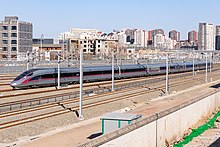

All variants of Fuxing train are compatible. The EMU models shares the same standard required by China Railway Corporation, hence the name China Standardized EMU. Fuxing train models can be identified by the designation. The number in the designation represents the speed class in kilometers per hour. The first letter after speed is the manufacturer code, with A being the CRRC Qingdao Sifang and B being the CRRC Changchun Railway Vehicles. The second letter after the speed represents whether the train set is powered by self-propelled multiple units or locomotives.
For CR400AF and CR400BF series EMUs, there may also be a letter as a sub-model.
A represents the 16-car grouping. Compared with the ordinary standard type, carriages 8 and 9 are designed to be connected. B represents the 17-car grouping. Compared with the 16-car grouping, one second-class car is added to increase the passenger flow capacity during peak periods. G stands for those that can operate in harsh conditions. Although the overall data and structure are the same as the ordinary standard type, it has the added ability to withstand wind, sand, rain, snow, fog, ultraviolet rays and other severe weather. It can drive in low-temperature environments of –40 °C. Some variants have two letters indicating combined configuration, such as type GZ being the train set featuring sandstorm and cold resistant capability (type G) and redesigned interior and exterior (type Z).[25]
- CR400AF
- 8-car standard production model with standard maximum speed of 420 km/h (260 mph). It is manufactured by CRRC Qingdao Sifang.[26][27]


- KCIC400AF/AF-CIT
- Exported to Indonesia a derivative of the CR400AF for Jakarta-Bandung high speed line.[8]
- CR400AF–A
- 16-car version manufactured by CRRC Qingdao Sifang.[28] The first CR400AF-A started operation in July 2018 on the Beijing–Shanghai high-speed railway. These sets are 415 m (1,361 ft 7 in) long and have a passenger capacity of 1,193 passengers.[29]
- CR400AF–B
- 17-car version manufactured by CRRC Qingdao Sifang. Testing started in 2018[30] and entered passenger service in 2019 in response to high passenger demand on the Beijing–Shanghai high-speed railway.[31][30] These sets are 440 m (1,443 ft 7 in) and have a passenger capacity of 1,283 people.[32]
- CR400AF–C
- 8-car ATO enabled version with redesigned interior and exterior. It is manufactured by CRRC Qingdao Sifang.
- CR400AF–G
- 8-car sandstorm and cold climate resistant version. It is manufactured by CRRC Qingdao Sifang.
- CR400AF–Z
- 8-car variant with redesigned and upgraded interior and exterior with business class featured in a 1-1 configuration instead of the typical 1-2 configuration. It is manufactured by CRRC Qingdao Sifang.
- CR400AF–BZ
- 17-car variant with redesigned and upgraded interior and exterior, with business class featured in a 1-1 configuration instead of the typical 1-2 configuration. It is manufactured by CRRC Qingdao Sifang.
- CR400AF–GZ
- 8-car sandstorm/cold resistant with redesigned and upgraded interior and exterior. It is manufactured by CRRC Qingdao Sifang.

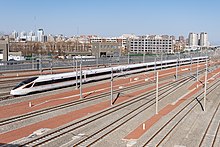

- CR400BF
- 8-car standard production model with standard maximum speed of 420 km/h (260 mph). It is manufactured by CRRC Changchun Railway Vehicles.
- CR400BF–A
- 16-car version manufactured by CRRC Changchun Railway Vehicles.[28] Testing of this variant started on March 9, 2018.[33] The first CR400BF-A started operation of the Beijing–Shanghai high-speed railway on June 29, 2018.[34] These sets are 415 m (1,361 ft 7 in) and have a passenger capacity of 1,193 people.[34]
- CR400BF–B
- 17-car version. It is manufactured by CRRC Changchun Railway Vehicles.[35]
- CR400BF–C
- 8-car ATO enabled version with redesigned interior and exterior used on the Beijing–Zhangjiakou intercity railway in preparation for the 2022 Winter Olympics. It is manufactured by CRRC Changchun Railway Vehicles.[36] The interior design incorporates snow and ice elements with blue ambient light. The train is also equipped with high-definition LED destination displays, wireless charging for business class seats, and smart glass windows. Additional features include snowboard storage and urine sampling areas.[37][38] The trains are manufactured by CRRC Changchun Railway Vehicles. CR400BF–C started operating on December 30, 2019, with the opening of the Beijing–Zhangjiakou ICR.[39]
- CR400BF–G
- 8-car sandstorm and cold climate resistant version for use in more extreme weather. It is manufactured by CRRC Changchun Railway Vehicles.[40] Shares same exterior style as the CR400BF.
- CR400BF–Z
- 8-car variant with redesigned and upgraded interior and exterior with business class featured in a 1-1 configuration instead of the typical 1-2 configuration, with sliding doors. It is manufactured by CRRC Changchun Railway Vehicles.
- CR400BF–BZ
- 17-car variant with redesigned and upgraded interior and exterior with business class featured in a 1-1 configuration instead of the typical 1-2 configuration, with sliding doors. It is manufactured by CRRC Changchun Railway Vehicles.
- CR400BF–GZ
- 8-car sandstorm/cold resistant version with redesigned interior and exterior. It is manufactured by CRRC Changchun Railway Vehicles.


- CR300AF
- Introduced in 2018, with 300 km/h (190 mph) (Record) speed and a service speed of 250 km/h (155 mph). It is manufactured by CRRC Qingdao Sifang.
- CR300BF
- Introduced in 2018, with standard maximum speed of 300 km/h (190 mph), running at a speed of 250 km/h (155 mph). It is manufactured by CRRC Changchun Railway Vehicles.[35]
- CR200J
- Introduced in 2019, this 210 km/h (130 mph) record higher-speed version and a service speed of 160 km/h (100 mph) is designed by CRRC Nanjing Puzhen, CRRC Qingdao Sifang, CRRC Tangshan, CRRC Zhuzhou Locomotive, CRRC Datong and CRRC Dalian.[35]
Upcoming Models
[edit]The CR450 is a Fuxing train series currently under development. As of 2023, it has not yet been put into commercial operations but according to Zhao Hongwei, chief researcher of the China Academy of Railway Sciences, the train's general design is expected to be finalized in 2024.[41] The model is being produced from the China Railway 450 Technology Innovation Project, that was started by Beijing with the purpose to develop the next generation of high-speed trains, and part of China's fourteenth five-year plan between 2021 and 2025.[42][43]
The train encompasses nine new independently developed technologies that includes carbon ceramic braking, pantograph active control, eddy current braking, and permanent magnet traction systems. Since April 2023, the new model has undertaken over 60 tests to evaluate its dynamics when running on tracks and going though tunnels, and as well as train meet scenarios, where two trains pass each other while moving in opposite directions. In June 2023, a CR450 sped at 453 km/h (281 mph) during a test run that travels through the Meizhou Bay cross-sea bridge, and its relative velocity had reached 891 km/h (554 mph), which set a new world record for the fastest closing speed among two trains passing each other.[44][42][45]
It is expected to enter service by 2025 with a top operating speed of 400 km/h (249 mph), surpassing the current fastest operating speeds of other high-speed trains in China, and additionally exceeding the current maximum operating speeds for high-speed trains in Japan and France that are limited to go up to 320 km/h (199 mph).[46][47][9]
Specification
[edit]| Train type | Car dimensions | Total length | Top speed | Seating capacity | Formation | Power output (under 25 kV) |
Entry into Service |
|---|---|---|---|---|---|---|---|
| CR400AF/AF–A/AF–B | |||||||
| CR400AF | End cars length: 27.91 m (91 ft 7 in) Inter cars length: 25.65 m (84 ft 2 in) Width: 3.36 m (11 ft 0 in) Height: 4.05 m (13 ft 3 in) |
Calculated: 209.72 m (688 ft 1 in) Real: 209 m (685 ft 8 in) |
Test: 420 km/h (261 mph) Design: 400 km/h (249 mph) Continuous operation: 400 km/h (249 mph) Current operation: 350 km/h (217 mph) |
556: 10 business, 28 first and 518 standard 576: 10 business, 28 first and 538 standard 392: 10 business, 24 first and 358 standard |
4M4T | 10.4 MW (13,947 hp) | August 15, 2016 |
| CR400AF–A | Calculated: 414.92 m (1,361 ft 3 in) Real: 414 m (1,358 ft 3 in) |
1193: 22 business, 148 first and 1023 standard | 8M8T | 19.2 MW (25,748 hp) | June 16, 2018 | ||
| CR400AF–B | Calculated: 438.928 m (1,440 ft 0.6 in) Real: 439.8 m (1,442 ft 11 in) |
1283: 22 business, 148 first and 1113 standard | 8M9T | January 5, 2019 | |||
| CR400BF/BF–A/BF–B/BF–C/BF–E/BF–G | |||||||
| CR400BF | End cars length: 27.089 m (88 ft 10.5 in) Inter cars length: 25.65 m (84 ft 2 in) Width: 3.36 m (11 ft 0 in) Height: 4.05 m (13 ft 3 in) |
Calculated: 208.078 m (682 ft 8.0 in) Real: 209 m (685 ft 8 in) |
Test: 420 km/h (261 mph) Design: 400 km/h (249 mph) Continuous operation: 400 km/h (249 mph) Current operation: 350 km/h (217 mph) |
556: 10 business, 28 first and 518 standard 576: 10 business, 28 first and 538 standard |
4M4T | 10.14 MW (13,598 hp) | August 15, 2016 |
| CR400BF–C | 576: 10 business, 28 first and 538 standard 541: 10 business, 28 first and 503 standard |
December 30, 2019 | |||||
| CR400BF–G | 576: 10 business, 28 first and 538 standard | June 9, 2019 | |||||
| CR400BF–A | Calculated: 413.278 m (1,355 ft 10.8 in) Real: 414 m (1,358 ft 3 in) |
1193: 22 business, 148 first and 1023 standard | 8M8T | 20.28 MW (27,196 hp) | June 12, 2018 | ||
| CR400BF–S | 880: 880 soft sleepers | Under testing | |||||
| CR400BF–B | Calculated: 438.928 m (1,440 ft 0.6 in) Real: 439.8 m (1,442 ft 11 in) |
1283: 22 business, 148 first and 1113 standard | 8M9T | January 5, 2019 | |||
| CR300 | |||||||
| CR300AF | Power car length: Unknown | Calculated: 208.95 m (685 ft 6 in) | Test: N/A | 565: 48 first, 565 standard | 4M4T | TBD | 2018 |
| CR200J | |||||||
| CR200J (Short) | Power cars length: 20 m (65 ft 7 in) Inter cars length: 25.5 m (83 ft 8 in) Control car length: 27.955 m (91 ft 8.6 in) Width: 3.105 m (10 ft 2.2 in) Height: 4.433 m (14 ft 6.5 in) |
Calculated: 226.455 m (742 ft 11.6 in) Real: 234 m (767 ft 9 in) |
Test: N/A Design: 210 km/h (130 mph) Continuous operation: 160 km/h (99 mph) Current operation: 160 km/h (99 mph) |
690: 690 standard | 1M7T1Tc | TBD | January 5, 2019 |
| CR200J (Long) | Calculated: 448 m (1,469 ft 10 in) Real: 518 m (1,699 ft 6 in) |
918: 242 standard, 280 first class sleepers and 396 second class sleepers | 2M16T | TBD | |||
Incidents and equipment issues
[edit]- On 8 February 2018, a train no. G89 from Beijing West railway station to Chengdu East railway station, serviced by CR400BF-5033 (with 576 seats), was forced to discontinue its journey at Xi'an North railway station, due to a mechanical malfunction (hot box). No passengers were injured. Passengers were then transferred to a CRH380B train set with only 556 seats.[48]
- On 27 June 2018, train no. G123 from Beijing South railway station to Shanghai Hongqiao railway station was late by 49 minutes, as it sustained an equipment failure due to an earlier service G239 which is provided by Hexie type CRH380B EMU.[49]
- On 12 August 2018, train no. G40 from Hangzhou East railway station to Beijing South railway station collided with a flying steel plate, which was blown away from a nearby construction site close to Langfang railway station. The flying steel plates not only damaged the train itself, but caused serious traffic disruptions on the Beijing–Shanghai high-speed railway as the overhead catenary also sustained damages. Passengers were transferred to buses, while the damaged train was hauled to Beijing South railway station by a Dongfeng 11 diesel locomotive.[50]
- On 26 September 2018 an inbound CR400BF-A trainset was unable to properly open its doors at Hong Kong West Kowloon railway station, as the platform edge reached beyond the track's structure gauge. The vehicle was redirected to a different platform. No injuries were reported.[51]
- During the one week holiday of the National Day of the People's Republic of China (October 1–7, 2018), various services of Fuxing were forced to stop at intermediate stations along their routes, as they had been immobilized by the crowd of passengers, causing traffic disruptions. Unlike Hexie, Fuxing trains are equipped with devices that are capable of detecting certain levels of overcrowding, preventing them from any further movement to ensure safety until train staff manage to remove the necessary number of passengers.[52]
- On 17 October 2018, China Railway Shanghai Group reported that it has implemented portable air quality measurement devices to monitor the level of hazardous fumes emitted by possibly substandard heat resistant surfaces in the passenger carriages as several complaints have been recorded by passengers and train drivers, stating the smell in the carriages is unbearable. Some passengers also suffered minor respiratory diseases such as coughing and sore throat.[53]
- On October 14, 2019, a train bound for Kaihua Station had smoke present in the machinery room of its rear locomotive. Upon discovering this, the driver immediately disconnected the main circuit breaker and took measures to slow down. Later, while running, the rear locomotive suddenly broke down in smoke, and was promptly stopped for treatment. The locomotive failure and fire were then dealt with without causing any casualties. The train later arrived at its destination, 201 minutes later than planned. The locomotive involved in the accident was newly built in December 2018, and had traveled 131,498 kilometers at the time of the accident.[54][better source needed] The specific cause of the fire was a loose wire contacting with the main control panel cabinet, causing the control panel to short circuit and catch fire. Yongji Motor later paid 80 million Yuan in compensation to the China State Railway Group.[55][56]
Gallery
[edit]-
CRH-0207 testing in the National Railway Test Center, Beijing
-
CRH-0305 at National Railway Test Center, Beijing
-
CR400AF-2146 at Beijing West railway station awaiting departure to Daxing International Airport
-
CR400BF-A to Shanghai Hongqiao railway station
-
CR400BF-B departing Beijing South railway station to Shanghai Hongqiao railway station
-
CR400BF-BZ at Beijing South railway station
-
CR400BF-BS leaving Beijing South railway station
-
CR400BF-C at Qinghe railway station
-
CR400BF-G at Beijing North railway station
-
CR400BF-GZ at Beijing Chaoyang railway station
-
CR300AF on the Guangzhou–Shenzhen railway
-
CR300BF at National Railway Test Center, Beijing
-
CR200J on the Beijing-Kowloon railway
-
CR200J on the Boten–Vientiane railway
-
Business class seats on CR400AF-B-2116
-
Redesigned business class seats on CR400BF-GZ-5143.
-
First Class cabin interior on CR400AF-B-2119
-
Second class interior on CR200J
-
Seating sign on CR400BF with booking status indicators: red indicators refer to booked and green for empty.
See also
[edit]- China Railway High-speed, Chinese high-speed railway service provided by China Railway.
- China Railway, Chinese state-owned corporation that operates all Fuxing trains.
- Hexie (train), a previous generation of EMUs operated by China Railway.
- E5 and H5 Series Shinkansen
- E6 Series Shinkansen
References
[edit]- ^ a b c d e f g ""中国标准"动车组正式下线 时速350公里". ifeng.com. 30 June 2015.
- ^ "Fuxing Hao Series Bullet Trains". Railway Technology. Retrieved 10 March 2024.
- ^ Chakraborty, Aninda (26 June 2017). "China introduces new high-speed Fuxing train". Railway Technology. Retrieved 10 March 2024.
- ^ a b "350km/h China Standard EMU Rolled Off the Line". China Railway. 30 June 2015.
- ^ a b "China EMU train linking Datong and Xi'an passes high speed test". Xinhua. 18 November 2015. Archived from the original on 20 November 2015.
- ^ a b "Chinese bullet trains cross in historic first". Xinhua. 15 July 2016. Archived from the original on 15 July 2016.
- ^ Kereta Cepat Indonesia China [@keretacepat_id] (22 December 2021). "Sobat #KeretaCepat, siapa di sini yang sudah tidak sabar menantikan 2022, serta melajunya Si Komodo Merah di Trial Run nanti?" (in Indonesian) – via Instagram.
- ^ a b Kereta Cepat Indonesia China [@keretacepat_id] (25 May 2022). "Jadi EMU KCJB memiliki nama tipe KCIC400AF, dan KCIC400AF-CIT untuk kereta inspeksinya. Hal tersebut sudah menjadi standar penamaan dari pihak konsorsium mengingat EMU dan CIT KCJB memiliki konfigurasi khusus yang menjadikannya unik dan berbeda dengan tipe lainnya" (in Indonesian) – via Instagram.
- ^ a b "Chinese scientists hope to smooth the path of new 400km/h bullet trains". South China Morning Post. 3 September 2022. Retrieved 12 September 2023.
- ^ 郭凯. "Tech upgrades power trains to 453 km/h during tests". www.chinadaily.com.cn. Retrieved 10 March 2024.
- ^ a b Shirouzu, Norihiko (17 November 2010). "Train Makers Rail Against China's High-Speed Designs". The Wall Street Journal. Retrieved 26 December 2012.
- ^ Wines, Michael; Bradsher, Keith (17 February 2011). "China Rail Chief's Firing Hints at Trouble". The New York Times. Retrieved 27 December 2012.
Many multinational companies also resent China for tweaking foreign designs and building the equipment itself rather than importing it.
- ^ Johnson, Ian (13 June 2011). "High-Speed Trains in China to Run Slower, Ministry Says". The New York Times. Retrieved 27 December 2012.
In the past few months, some foreign companies that sold China its high-speed technology said the trains were not designed to operate at 215 miles per hour. The ministry said that Chinese engineers had improved on the foreign technology and that the trains were safe at the higher speeds.
- ^ a b ""CNR Changchun-made" Chinese-standard EMU Rolled Off the Production Line". Jilin Daily. 6 July 2015. Archived from the original on 24 November 2016. Retrieved 24 November 2016.
- ^ "Chinese Standard Debuts New Speed of 350 km/h". People's Daily Online. 1 July 2015.
- ^ a b c d "China's Standard high-speed EMU enters service". International Railway Journal. 15 August 2016.
- ^ "Chinese high-speed train passes speed test at 385 km/h". Xinhua. 19 November 2015.
- ^ ""复兴号"来了 中国标准动车组时代来了_第A15版:时事·九州/专题_ 2017-06-27 _南方日报数字报_南方网". epaper.southcn.com. Retrieved 11 June 2020.
- ^ a b "China Standardized EMUs start operation". CRRC. 18 August 2016.
- ^ 国家铁路局行政许可决定书(国铁许准字〔2016〕第720号). www.nra.gov.cn. Archived from the original on 11 August 2017. Retrieved 25 June 2017.
- ^ 国家铁路局行政许可决定书(国铁许准字〔2016〕第722号). www.nra.gov.cn. Archived from the original on 11 August 2017. Retrieved 25 June 2017.
- ^ 国家铁路局行政许可决定书(国铁许准字〔2017〕第079号). www.nra.gov.cn. Archived from the original on 11 August 2017. Retrieved 25 June 2017.
- ^ 中国标准动车组命名"复兴号". Xinhua News Agency. 25 June 2017.
- ^ 韩家慧. ""复兴号"开展时速350公里体验运营 京沪高铁全程缩至4个半小时-新华网". www.xinhuanet.com. Archived from the original on 8 March 2018. Retrieved 11 June 2020.
- ^ "收藏+转发!复兴号家族最全图鉴来了". Tencent News (in Chinese). 19 April 2021.
- ^ "时速350公里中国标准动车组下线--国家知识产权局". archive.is. 17 October 2015. Archived from the original on 17 October 2015. Retrieved 11 June 2020.
- ^ "国家铁路局向中国标准动车组颁发许可证_国家铁路局". www.nra.gov.cn. Archived from the original on 25 February 2021. Retrieved 11 June 2020.
- ^ a b "加长版复兴号下月京沪间开跑". Archived from the original on 12 June 2018. Retrieved 9 June 2018.
- ^ "Longest high-speed trains go into service - SHINE". SHINE. Retrieved 7 July 2018.
- ^ a b 北京青年报 (3 October 2018). "17辆超长版复兴号现身北京 明年投入京沪高铁运营". news.sina.com.cn. Retrieved 11 June 2020.
- ^ "多加一节,17编组复兴号又添这些创新点-新华网". www.xinhuanet.com. Retrieved 9 November 2019.
- ^ "超长版时速350公里"复兴号"上线运营-中新网". www.chinanews.com. Retrieved 11 June 2020.
- ^ "世界首列加长版"复兴号"正试验 时速350公里". www.guancha.cn. Retrieved 11 June 2020.
- ^ a b "7月1日全国铁路调图 加长版复兴号将首次上线京沪高铁-新华网". www.xinhuanet.com. Archived from the original on 1 July 2018. Retrieved 11 June 2020.
- ^ a b c "Three New Types of Fuxing Bullet Trains Unveiled_Media_news Details_CRRC". www.crrcgc.cc. Retrieved 10 June 2020.
- ^ "京张高铁昨日首发 350公里时速 车厢智能随手触-新华网". www.xinhuanet.com. Archived from the original on 1 January 2020. Retrieved 11 June 2020.
- ^ "京张高铁今日开通,列车全球首次时速350公里以上自动驾驶". www.guancha.cn. Retrieved 11 June 2020.
- ^ "京张高铁智能动车组上线联调联试-新华网". www.xinhuanet.com. Archived from the original on 30 December 2019. Retrieved 11 June 2020.
- ^ 蘇子牧 (30 December 2019). "京張高鐵今開通 全球首次實現時速350公里自動駕駛". 香港01 (in Chinese (Hong Kong)). Retrieved 11 June 2020.
- ^ Feng, David (11 September 2019). "Linking China's Railways from the Capital to The Great Northeast". Medium. Retrieved 10 June 2020.
- ^ Rogers, David (13 March 2023). "China Railways to debut 450km/h bullet train "in near future"". Global Construction Review. Retrieved 12 September 2023.
- ^ a b Tiwari, Sakshi (3 July 2023). "At 453 KM/H, China Tests World's Fastest, New-Gen High-Speed Train That Is Safer, Energy-Efficient & Intelligent". Latest Asian, Middle-East, EurAsian, Indian News. Retrieved 12 September 2023.
- ^ "How to make a bullet train faster? Give it wings, Chinese scientists say". South China Morning Post. 22 November 2021. Retrieved 12 September 2023.
- ^ "China sets new record in high-speed rail closing speed". The Korea Post (in Korean). 24 May 2022. Retrieved 12 September 2023.
- ^ "China successfully tests new high-speed trains at top speeds of 453 km/h". www.thecivilengineer.org. Retrieved 12 September 2023.
- ^ "China's new high-speed train just set a new record as the world's fastest — and it could travel faster than an airplane". Yahoo News. 4 September 2023. Retrieved 12 September 2023.
- ^ Paleja, Ameya (3 July 2023). "At 281 miles an hour, China's new high-speed maglev train is the world's fastest". interestingengineering.com. Retrieved 12 September 2023.
- ^ Bingyang, Lu (8 February 2018). "G89次复兴号首次入川遇故障 乘客西安临时换车". Sina.com. Retrieved 12 February 2018.
- ^ "复兴号晚点暴露出的问题". people.com.cn. 28 June 2018. Retrieved 13 July 2018.
- ^ "京沪高铁线遭彩钢板撞击 导致多趟列车停运". Xinhua. 18 August 2018. Retrieved 30 October 2018.[dead link]
- ^ Zhuang, Gongnan (27 September 2018). "高鐵又甩轆?譚文豪:8號月台疑設計缺陷 有列車無法正常開門". hk01.com. Retrieved 30 September 2018.
- ^ ""复兴号"超员就走不动?铁总回应". CCTV. 9 October 2018. Retrieved 30 October 2018.
- ^ "中铁总从源头整治动车异味 有权要求中车召回并索赔". Sina.com. 18 October 2018. Retrieved 8 November 2018.
- ^ "2019年10月14日,上海局集团公司CR200J-6001号动集发生一起冒烟(起火),通报如下" (in Chinese). Archived from the original on 17 October 2019. Retrieved 27 September 2023.
- ^ "一上海出发列车突发火情 铁路局:及时处置未造成伤亡". 中国新闻网 (in Chinese). 15 October 2019. Archived from the original on 15 October 2019. Retrieved 16 October 2019.
- ^ 路炳阳 (15 October 2019). "D5689次复兴号起火 机车火灾事故隐患亟待整治". 中国经营网 (in Chinese). Archived from the original on 15 October 2019. Retrieved 16 October 2019.
- "加长版"复兴号"下月起运营" [The extended version of the "Rejuvenation" will operate from next month]. Fawan.com (in Chinese). June 2006. Archived from the original on 2 July 2018. Retrieved 2 July 2018.




